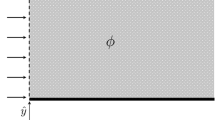Abstract
We derive a set of governing equations for flow through porous obstacles by employing a two-step averaging processes. The Navier-Stokes equations under the Boussinesq approximation that describe the air space of the porous obstacle are subjected to high-wavenumber a veraging, which leads to a set of high-frequency (wake) turbulence equations. We then use conventional Reynolds-averaging methods to obtain statistically steady mean and turbulence equations that include interactions between wake and shear turbulence. Our method provides a theoretical basis for the cascade of turbulent kinetic energy. We use this approach to analyze the constants and parameters of simpleK-theory and higher-order closure models. We also discuss qualitatively the theory of the turbulence energy generation process and the significance of interactions between different turbulent mechanisms.
Similar content being viewed by others
Abbreviations
- 〈〉:
-
Air-phase high-wavenumber-averaged value
- Overbar (—):
-
All-wavenumber-averaged value
- Double prime ("):
-
Departure of avariable from its air-phase high-wavenumber-averaged value
- Single prime ('):
-
Departure of variable from its all-wavenumber-averaged value
- A :
-
Leaf surface area density
- C d :
-
Drag coefficient for unit plant area density
- d :
-
Characteristic length scale of obstacle elements
- D :
-
Characteristic length scale of air-phase high-wavenumber-averaging volume
- E :
-
High-frequency turbulent kinetic energy
- e :
-
Low-frequency turbulent kinetic energy
- F i :
-
Drag force ini direction exerted on air flow by obstacle elements
- f k :
-
Coriolis parameter
- g :
-
Acceleration vector due to gravity
- H :
-
Macroscopic variables
- i, j, k, l :
-
Subscript variables, indicating 3 directions
- L :
-
Length scale of wind shear (atmospheric turbulence)
- n, n i :
-
Vector and its component ini direction of the air-solid interface
- p :
-
Atmospheric pressure
- P s :
-
Wind-shear turbulence production rate
- P w :
-
Wake-turbulence production rate generated by air-obstacle element interaction
- S :
-
Air-solid interface surface in the air-phase high-wavenumber-averaging volume
- t, T :
-
Time and time scale
- U :
-
Total mean windspeed
- u i :
-
Windspeed in three directions
- V :
-
Volume of the air-phase high-wavenumber-averaging process
- V a :
-
Air volume in the averaging process
- V s :
-
Solid element volume in the averaging process
- W s :
-
Movement velocity of solid element in the averaging volume
- x i :
-
i=1, 2, 3 — three direction coordinate,x, y, z
- ɛijk :
-
Einstein summation symbol
- ɛe :
-
Dissipation rate of low-frequency turbulence
- ρ0 :
-
Air density
- θ:
-
Potential temperature disturbance
- ν:
-
Coefficient of air molecular viscosity
- β:
-
Coefficient of air thermal expansion
- σ:
-
Turbulence intensity
- Λ:
-
Mixing length of obstacle-free atmosphere
- Λ':
-
“Mixing length” of porous obstacle flows
References
Finnigan, J. J.: 1985, ‘Turbulent Transport in Flexible Plant Canopies’, in B. A. Hutchison and B. B. Hicks (eds.),The Forest-Atmosphere Interaction, D. Reidel Publishing Company, Dordrecht/Boston/Lancaster, pp. 443–480.
Gao, W., Shaw, R. H., and Paw U, K. T.: 1989, ‘Observation of Organized Structure in Turbulent Flow within and above a Forest Canopy’,Boundary-Layer Meteorol. 47, 349–377.
Kolmogorov, A. N.: 1942, ‘Equations of Turbulent Motion of an Incompressible Fluid’,Izv. Akad. Nauk. SSSR Ser. Fiz. 6, 56–58.
Li, Z., Lin, J. D., and Miller, D. R.: 1990, ‘Air Flow Over and Through a Forest Edge: A Steady-State Numerical Simulation’,Boundary-Layer Meteorol. 51, 179–197.
Lin, J. D. and Miller, D. R.: 1985, ‘A Preliminary Field Study of Turbulent Flow over and inside a Forest Edge’,Tech. Dept. U.S. ARO. Renewable Natural Resources Dept. University of Connecticut. pp. 120.
Miller, D. R., Lin, J. D., and Lu, Z. N.: 1991, ‘Air Flow Across an Alpine Forest Clearing: A Model and Field Measurements’,Agric. For. Meteorol. 56, 209–225.
Raupach, M. R.: 1988, ‘Canopy Transport Process’, in W. L. Steffan and O. T. Denmead (eds.),Flows and Transport in the Natural Environment: Advances and Applications, Springer-Verlag, Berlin, pp. 95–127.
Raupach, M. R., Coppin, P. A., and Legg, B. J.: 1986, ‘Experiments on Scalar Dispersion within a Model Plant Canopy. Part I: the Turbulence Structure’,Boundary-Layer Meteorol. 35, 21–52.
Raupach, M. R. and Shaw, R. H.: 1982, ‘Averaging Procedures for Flow Within Vegetation Canopies’,Boundary-Layer Meteorol. 22, 79–90.
Thom, A. S.: 1975, ‘Momentum, Mass and Heat Exchange of Plant Communities’,Vegetation and the Atmosphere, Vol. 1, Academic Press, pp. 1–278.
Whitaker, S.: 1969, ‘Advances in Theory of Fluid Motion in Porous Media’,Ind. Eng. Chem. 61, 14–28.
Whitaker, S.: 1973, ‘The Transport Equations for Multi-Phase System’,Chem. Eng. Sci. 28, 139–147.
Wilson, J. D.: 1985, ‘Numerical Studies of Flow Through a Windbreak’,J. Wind Eng. Ind. Aerodyn. 21, 119–154.
Wilson, J. D.: 1988, ‘A Second-Order Closure Model for Flow Through Vegetation’,Boundary-Layer Meteorol. 42, 371–392.
Wilson, N. R. and Shaw, R. H.: 1977, ‘A higher Order Closure Model for Canopy Flow’,J. Appl. Meteorol. 16, 1197–1205.
Zhu, T. (ed.): 1992,The Study of Ecological Effects and Physical Characteristics in the Boundary Layer of Protective Forest System, Chinese Meteological Press, pp. 1–266.
Author information
Authors and Affiliations
Rights and permissions
About this article
Cite this article
Wang, H., Takle, E.S. Boundary-layer flow and turbulence near porous obstacles. Boundary-Layer Meteorol 74, 73–88 (1995). https://doi.org/10.1007/BF00715711
Revised:
Issue Date:
DOI: https://doi.org/10.1007/BF00715711




